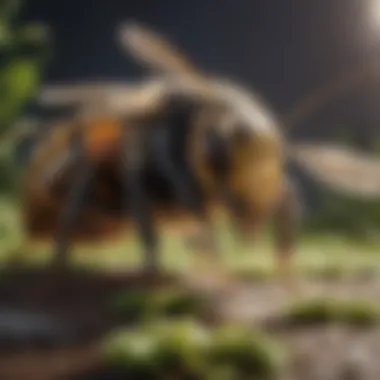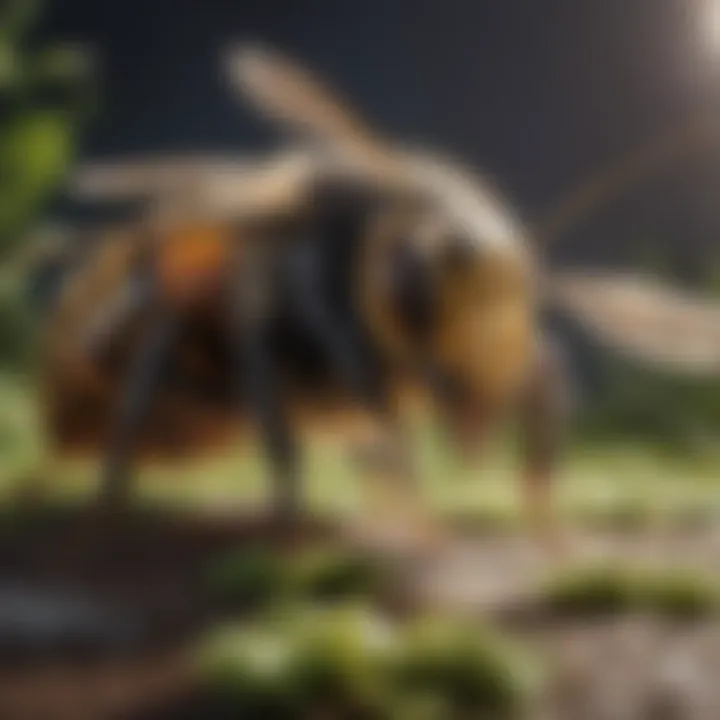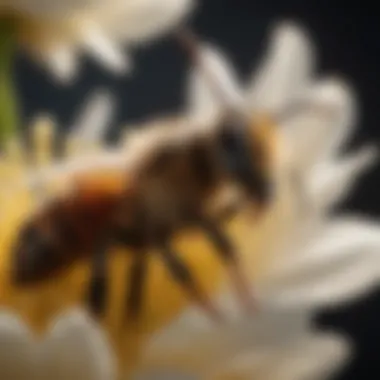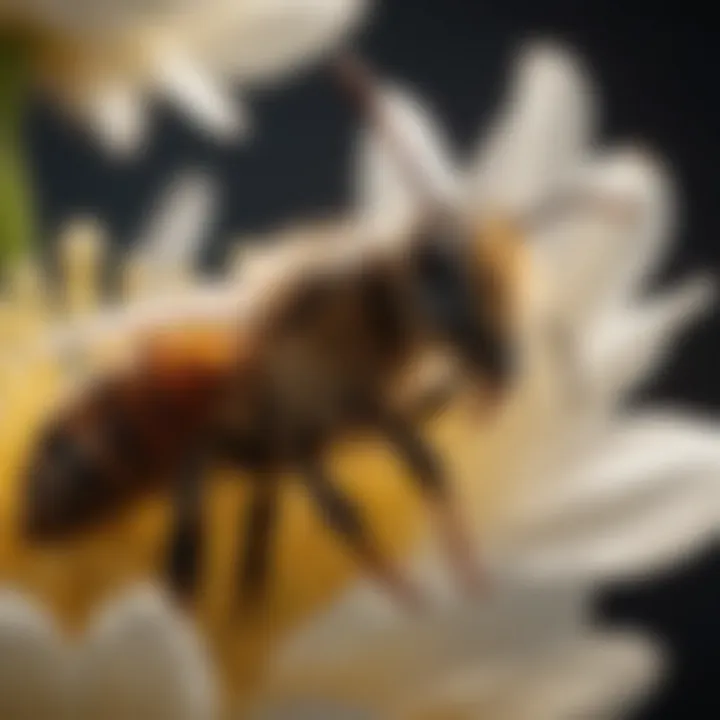Bee Smart Pest Control: Eco-Friendly Strategies


Intro
Pest control has become a vital topic as homeowners seek effective methods to ensure their living spaces are free from unwanted critters. The challenge lies in managing these pests without harming beneficial organisms, particularly bees. Innovative approaches are necessary for a balanced ecosystem and safer environments for families.
Understanding the Pest
Identification
Understanding pests begins with proper identification. Different pests can invade homes, and each has its own behavior and management techniques. Common pests include ants, cockroaches, mice, and termites. Homeowners must learn to recognize these pests to decide on the best control methods. Accurate identification can aid in preventing infestations and minimize the potential for harm to beneficial insects, especially pollinators like bees.
Life Cycle
Next, knowing the life cycle of pests helps in effectively managing their populations. Most pests go through distinct stages: egg, larva, pupae, and adult. For example, the American cockroach lays eggs in dark, warm areas, which then develop into nymphs before reaching adulthood. Recognizing these stages allows homeowners to target their intervention at the most effective time, reducing the likelihood of reinfestation.
Pest Prevention Strategies
Environment Modification
To create an environment that discourages pests from invading, consider modifying the surroundings. This involves eliminating standing water, sealing cracks, and removing clutter where pests can hide. Additionally, planting native vegetation can help create a healthy ecosystem that supports bees and other beneficial insects.
- Dispose of garbage regularly.
- Keep food in sealed containers.
- Ensure proper drainage in yards.
These steps not only limit the attractiveness of the area for pests but also support native wildlife.
Physical Barriers
Physical barriers can be effective in preventing pests from accessing homes. This can include installing screens on windows and doors, sealing gaps in foundations, and using mesh on vents. Physical barriers are a simple way to reduce pest entry points without chemical intervention, thus preserving beneficial insects.
Control Methods
Chemical Control
While chemicals can provide immediate results, they come with risks. Homeowners need to select targeted pesticides that do not harm bees and other beneficial insects. Integrated Pest Management (IPM) suggests using chemical controls as a last resort.
- Read labels carefully.
- Apply pesticides during times when bees are not active.
This method ensures that safety is a priority while effectively controlling pest populations.
Biological Control
Biological control relies on introducing natural predators or competitors to manage pest populations. This approach can effectively reduce pest numbers while preserving beneficial insects like bees. For example, ladybugs eat aphids, a common pest on many plants.
Using biological controls can enhance the overall sustainability of pest management practices while protecting the ecological balance.
"Adopting a strategy that embraces both pest control and the protection of beneficial wildlife fosters a healthier environment for all."
Understanding pest control within this framework brings various benefits:
- It addresses pest issues without the excessive use of harmful chemicals.
- It aligns pest management efforts with environmental sustainability.
- It promotes awareness among homeowners about the ecological impact of their choices.
Additionally, by integrating innovative technologies and eco-friendly practices, homeowners can achieve effective pest management. The strategies discussed in this article serve as a guide for individuals who are keen on maintaining a healthy home while being kind to the environment.
Understanding the Importance of Pest Control
Pest control plays a crucial role in ensuring the comfort and safety of living spaces. Beyond merely eliminating unwanted creatures, it encompasses a broader responsibility of maintaining a healthy habitat. Failing to address pest problems can lead to structural damage, health risks, and even financial losses. Household pests, often unassumingly infiltrating our homes, can cause significant disturbances.
For instance, rodents can compromise the integrity of buildings by gnawing through materials. Insects like termites are notorious for their destructive tendencies. Moreover, many pests carry diseases that can affect human health. Thus, effective pest control not only preserves the physical aspects of a home but also ensures a safe living environment.
The Role of Bees in the Ecosystem
Bees are indispensable in our ecosystem. The significance of bees extends beyond honey production; they are vital pollinators for many plants, including food crops. It is estimated that one-third of the food we consume relies on pollination, with bees being responsible for a considerable portion of this process. Without their pollination effort, we would see a drastic decline in food variety and availability.
Bees also contribute to maintaining and improving biodiversity. By pollinating a wide array of flowering plants, they support various forms of life that depend on these plants for food and habitat. Protecting bee populations must be a priority within pest control strategies; safeguarding their habitats and minimizing pesticide use can help ensure their survival.
"If bees were to disappear from the surface of the Earth, humans would have no more than four years left to live." – Albert Einstein
Understanding the importance of pest control through the lens of bee conservation encourages a more compassionate and responsible approach to managing pests. It illustrates the interconnectedness of various organisms and the impact of our actions on the environment.
Pest Identification Techniques
Identifying pests is a critical component of effective pest management. Accurate identification allows homeowners to recognize the problems facing their properties. This knowledge not only aids in choosing the appropriate pest control measures but also helps ensure the safety of beneficial insects, including bees. Without proper identification, control efforts may not only fail but could inadvertently harm non-target species.
Understanding pest identification techniques can lead to more sustainable practices by allowing homeowners to act based on the specific types of pests they encounter. It provides insight into the behavior, lifecycle, and ecological role of these pests. Knowing whether an insect is harmful or beneficial can influence decisions that promote or detract from the health of the overall ecosystem.
Common Household Pests
Common household pests include ants, cockroaches, rodents, and spiders. Their presence can indicate various issues, such as poor sanitation or structural problems.
- Ants: These social insects are attracted to food and can contaminate supplies. Identifying their trails can help locate nests.
- Cockroaches: They are nocturnal and prefer damp places. Their droppings and shed skins can signal an infestation.
- Rodents: Signs include gnaw marks, droppings, and nests. They can cause damage and spread disease.
- Spiders: Though many are harmless, some can be venomous. Identification requires looking at coloration and web type.
Recognizing these pests involves observing their behaviors, habitats, and physical characteristics. Utilizing resources like pest identification guides can assist homeowners in this process.
How to Identify Beneficial Insects
Beneficial insects play vital roles in pest control, pollination, and maintaining ecological balance. Identifying them can lead to informed decisions that benefit gardens and lawns.
Some common beneficial insects include:
- Ladybugs: Known for their red and black spotted bodies, these insects consume aphids and other pests.
- Butterflies and Bees: These pollinators aid in plant reproduction. Their colorful presence is often welcome in gardens.
- Predatory Wasps: They control the population of various pests by laying eggs in or on them.
To identify beneficial insects, homeowners can:


- Observe their behavior: Noticing what pests they target helps determine their role in pest management.
- Utilize reference materials: Field guides or online resources provide pictures and descriptions.
- Engage with local gardening groups: Forums or social media can offer help in identifying unfamiliar insects.
Maintaining a healthy population of beneficial insects may enhance natural pest control and promote biodiversity in home gardens.
Behavioral Understanding of Pests
Understanding the behavior of pests is crucial in the context of effective pest management. This knowledge helps in tailoring interventions that not only eliminate unwanted creatures but also consider the ecological impact. Each pest species exhibits unique feeding habits, reproductive cycles, and attraction triggers. Familiarity with these factors allows for precise tactics to manage these populations while minimizing harm to beneficial insects like bees.
Behavioral insights contribute to the development of eco-friendly strategies, allowing homeowners to implement solutions that are sustainable and effective. For instance, knowing when a pest is most active can inform optimal timing for treatment, reducing chemical use. Additionally, understanding feeding habits aids in identifying what attract pests to a space, facilitating preventive measures.
Overall, enhancing our knowledge about pest behavior isn't just about extermination; it's about fostering a healthier environment for all organisms involved in our ecosystem.
Feeding Habits and Lifecycle Stages
Feeding habits of pests are linked to their lifecycle stages. Different periods in a pest's life can highlight their diet preferences and impacts on homes. For example, the larvae of many pests may feed on different materials than adults. Recognizing this distinction assists in identifying the right strategies for management.
- Egg Stage: At this point, pests typically do not feed, but effective removal can prevent future infestations. Monitoring for eggs can save future trouble.
- Larval Stage: Larvae are often the most destructive, with feeding habits that can cause significant damage. Knowledge about what they consume helps in targeting interventions.
- Adult Stage: Adults often look for mates and food sources, thus are moving around and more visible. This activity can be exploited by utilizing traps or baits.
By focusing on these lifecycle stages, homeowners can deploy the right pest control measures at effective times. It also aids in understanding seasonal patterns, which can forecast pest surges.
Pest Attraction Factors
Pests are attracted to specific conditions found in or around homes. Understanding these factors can help in reducing the likelihood of infestations. Key attractions include:
- Food Sources: Most pests are drawn to easily accessible food. Keeping countertops clean and securing food in airtight containers can diminish pest attraction.
- Water Availability: Pests like cockroaches thrive in moist areas. Regularly checking for leaks and ensuring proper drainage can effectively reduce their presence.
- Shelter: Unkempt areas, such as cluttered garages or dense shrubbery, provide safe havens for pests. Maintaining tidy environments minimizes cover for these creatures.
Addressing these attractions will lead to fewer pests, reducing the need for extensive control measures, and contributes positively to the local ecosystem by protecting beneficial insects.
"Pest management is as much about prevention and understanding as it is about control. Knowing what brings them to your doorstep is half the battle."
Innovative Pest Control Technologies
Innovative pest control technologies play a crucial role in the development of effective pest management strategies. These technologies not only help in addressing the ongoing pest issues faced by homeowners but also significantly enhance the ability to protect beneficial insects like bees. As pest populations evolve, so must the techniques to manage them; therefore, understanding and utilizing these advanced methods can lead to more effective, sustainable outcomes.
Utilizing cutting-edge technologies results in improved precision and efficiency in pest control. It minimizes chemical usage and reduces harm to the environment, making it a vital consideration for responsible pest management. Advancements in this field offer new tools for monitoring and managing pests, allowing for better risk assessment and tailored interventions. Thus, they aid in achieving a pest-free home without compromising ecological balance.
Smart Traps and Monitors
Smart traps and monitors represent a significant leap in pest control technologies. These devices incorporate sensors and intelligent systems to detect pest activity. They provide real-time data to homeowners, allowing for timely interventions. This helps in reducing the chances of larger infestations.
Benefits of Smart Traps:
- Real-Time Monitoring: Smart devices can alert homeowners when pests are detected, facilitating prompt action.
- Data Collection: Users can analyze pest activity patterns over time, helping in understanding trends and implementing preventative measures.
- Reduced Chemical Use: By targeting specific pests, smart traps can reduce the need for broad-spectrum pesticides that may harm beneficial insects.
Considerations:
- Cost: Initial investment in smart technology may be higher than traditional methods.
- Technical Knowledge: Homeowners may need to familiarize themselves with using the devices effectively.
In summary, smart traps and monitors are critical tools in modern pest management. They align with environmentally friendly approaches, allowing for efficient pest control while safeguarding beneficial insects.
Drone Technology in Pest Management
Drone technology has emerged as a game-changer in pest management. Drones can cover large areas quickly, providing aerial surveillance of properties. This allows homeowners to monitor pest infestations from a unique perspective and identify problem areas that might be overlooked from the ground.
Applications of Drone Technology:
- Surveillance: Drones equipped with cameras can detect pest populations and assess the damages in landscapes and gardens.
- Targeted Treatments: Drones can apply organic pesticides or other treatments precisely where needed, minimizing waste and exposure to non-target species.
- Accessibility: For properties that are hard to reach or large plots of land, drones provide a convenient solution to pest assessment and management.
Considerations:
- Regulatory Compliance: Homeowners must understand local regulations regarding drone usage.
- Operational Knowledge: A basic understanding of drone operation may be required, which can be a barrier for some.
"Employing innovative pest control technologies ensures that pest management is effective, eco-friendly, and beneficial for all living organisms in the environment."
Overall, innovative pest control technologies, such as smart traps and drones, are essential in ensuring an integrated approach while considering environmental impacts. By embracing these advancements, homeowners can achieve pest control effectively and sustainably.
Eco-Friendly Pest Control Solutions
Eco-friendly pest control solutions represent a significant departure from traditional methods of managing pests. These approaches prioritize safety for both the environment and the beneficial insects that play crucial roles in ecosystems, especially bees. In a world where chemical pesticides are prevalent, understanding the multiple facets associated with eco-friendly solutions becomes imperative. It is not just about eliminating pests; it is about fostering a balanced ecosystem and ensuring harmony within our surroundings.
Adopting eco-friendly methods provides several benefits. Firstly, they tend to be safer for humans and pets. Chemical pesticides can lead to health issues, especially for children and animals that may have more sensitive bodies. Secondly, eco-friendly solutions protect beneficial insects, which are essential for pollination and maintaining biodiversity. By using methods that do not harm bees, we support the overall health of our gardens and landscapes.
Moreover, eco-friendly pest control often incorporates sustainable practices that benefit the long-term health of the environment. This approach encourages natural predators, using their lifecycle stages to keep pest populations in check. With a keen understanding of natural ecosystems, homeowners can implement strategies that not only resolve immediate pest issues but also promote a sustained healthy environment.
Of course, implementing eco-friendly pest control solutions requires consideration of various factors. Homeowners must assess the specific pests they face, understand their behaviors, and identify natural deterrents that could work. This may involve some experimentation and close monitoring to gauge what works best in each unique situation.
"Integrated pest management promotes the idea of observing, understanding, and responding effectively without harming the fragile balance of nature."
Natural Exclusion Methods
Natural exclusion methods play a vital role in eco-friendly pest control. These techniques emphasize preventing pests from entering a home or garden rather than eliminating them after they have already made themselves comfortable. Simple strategies can greatly reduce the opportunities pests have to invade a space.
Common practices for natural exclusion include:
- Sealing Entry Points: Check windows, doors, and cracks for possible entry points and seal them with appropriate materials.
- Proper Waste Management: Regularly dispose of waste and ensure trash bins are tightly sealed to avoid attracting pests.
- Landscaping Choices: Planting certain herbs and plants can deter pests while providing beauty to outdoor spaces. For example, lavender can deter moths, while marigolds can repel nematodes.
Natural exclusion methods are effective because they utilize the principles of environmental design. By understanding how pests behave and what attracts them, homeowners can create a less inviting atmosphere for these unwanted guests.
Organic Pesticides: Effectiveness and Safety
Organic pesticides emerge as a noteworthy option among eco-friendly solutions. They are derived from natural sources and designed to fight pests without the adverse effects associated with synthetic chemicals. While efficacy can vary, many organic pesticides have proven effective against certain pest issues.
Effectiveness: Organic pesticides, such as neem oil or diatomaceous earth, disrupt the lifecycle of pests or deter them from feeding. They can be potent tools in the hands of informed homeowners. However, it is essential to choose the right product for specific pest challenges. Researching and identifying effective organic options can lead to successful pest management without harming beneficial insects.


Safety: One of the main advantages of organic pesticides is their relative safety. Many of these products are biodegradable and break down more quickly in the environment. They pose fewer risks to humans, pets, and non-target insects, especially when compared to traditional pesticides. It is crucial to follow application instructions carefully to maximize safety and effectiveness.
Homeowners should always monitor the impact of any pesticide used, organic or not. Observing changes in pest populations and possible effects on non-target organisms helps refine pest management strategies. Being informed and actively involved leads to a more sustainable approach to pest control.
Integrated Pest Management Approach
The IPM approach offers multiple advantages:
- Sustainability: By focusing on long-term management strategies, IPM promotes environmental health and reduces chemical usage.
- Adaptability: IPM can be adjusted based on specific needs and conditions, making it applicable to diverse pest problems.
- Cost-Effectiveness: Over time, integrating various techniques can lead to lower pest management costs due to diminished pesticide dependence.
In implementing an IPM strategy, it is crucial to consider various elements. These include identifying pest species, understanding their life cycles, and recognizing the specific environmental factors that contribute to pest proliferation. By combining practices such as biological control, habitat manipulation, and mechanical methods, homeowners can achieve optimal pest management outcomes while safeguarding the ecosystem.
Combining Techniques for Optimal Results
To utilize the IPM approach effectively, combining different techniques is essential. This synergy allows for a comprehensive management strategy that can adapt to changing conditions. Some techniques homeowners can consider include:
- Cultural Controls: Altering practices such as planting diverse crops or adjusting irrigation can help deter pests naturally.
- Biological Control: Introducing beneficial insects, such as ladybugs or lacewings, can help naturally regulate pest populations.
- Mechanical Control: Physical barriers, like nets or traps, can be effective in preventing pests from causing damage.
Each method has its own strengths, and when applied together, they can create a robust defense against various pests. This combination approach increases the likelihood of success and ensures that pest management is effective without relying heavily on chemicals.
Evaluating and Monitoring Outcomes
To measure the success of the IPM strategies implemented, ongoing evaluation and monitoring are necessary. This involves regularly assessing pest populations and the effectiveness of the employed techniques. Homeowners can conduct visual inspections of plants and structures, noting any pest activity or damage. Also, keeping records of pest occurrences and environmental conditions can provide insight into trends and potential problem areas.
Monitoring is essential not just for measuring success, but also for adjusting strategies.
Regular evaluations allow for proactive measures, adapting to any emerging problems, and optimizing pest control methods as needed.
Using this data, homeowners can refine their IPM tactics, ensuring a more targeted approach that aligns with their specific conditions and pest challenges. Over time, this can lead to a significant reduction in pest populations, along with a healthier environment that supports beneficial insects.
Preventive Strategies for Homeowners
Preventive strategies are vital in maintaining a pest-free environment in the home. Understanding these practices helps homeowners stay proactive rather than reactive when it comes to pest management. By employing effective preventive measures, it is possible to significantly reduce the likelihood of pest infestations. These techniques not only protect the home but also the health of pets and family members. The benefits of preventive strategies extend beyond mere elimination; they foster long-term solutions that align with eco-friendly principles, making them essential in today’s environmentally conscious world.
Practices for a Pest-Free Home
There are several practical steps homeowners can take to maintain a pest-free space. These practices include:
- Regular Cleaning: Keeping the home clean is fundamental. It minimizes food sources for pests, reducing their chances to thrive. Regular vacuuming and sanitizing surfaces help eliminate crumbs, debris, and potential nesting areas.
- Sealing Entry Points: Inspecting the home for cracks and crevices is essential. Sealing these gaps with caulk or other materials can prevent pests from entering. Special attention should be paid to areas around windows, doors, and utility lines.
- Proper Food Storage: Storing food in airtight containers prevents pests from accessing it. Also, avoid leaving pet food out overnight. This simple measure can dramatically decrease the attraction for many unwanted guests.
- Landscape Maintenance: Keeping gardens tidy allows homeowners to understand their environment better. Regularly trimming plants and removing debris can deter pests from using the yard as habitat.
- Humidity Control: Many pests thrive in damp conditions. Using dehumidifiers and fixing leaks can create a less inviting atmosphere for these organisms.
Implementing these strategies can help in identifying potential pest problems before they become severe.
Gardening Techniques to Protect Beneficial Insects
Gardening practices are crucial for maintaining the balance of beneficial insects, such as bees and ladybugs, while managing pests. Here are some strategies homeowners can use:
- Plant Diversity: Incorporate a variety of plants. This creates habitats for different beneficial insects. Native plants often attract pollinators and can naturally keep pests in check.
- Avoiding Chemical Pesticides: The use of harsh chemicals can harm beneficial insects alongside pests. Homeowners should consider organic alternatives or targeted sprays that minimize harm.
- Companion Planting: Some plants can repel pests while attracting beneficial insects. For example, marigolds may deter nematodes, while attracting pollinators. Researching plants that work well together can enhance garden health and productivity.
- Providing Habitat: Creating areas of undisturbed soil or leaving patches of native plants can provide shelter for beneficial insects. These habitats allow populations of these insects to thrive and act as natural pest control.
"A balanced ecosystem is the foundation of natural pest control. Protecting beneficial insects contributes to the overall health of the garden."
By focusing on these gardening techniques, homeowners can ensure that they protect the insects that contribute positively to the environment while also keeping pests at bay.
Practicing these preventive strategies lays the groundwork for successful pest management. They empower homeowners to become active participants in their pest control efforts, cultivating sustainable habitats that support biodiversity.
The Role of Education in Pest Management
Education serves as a pivotal element in the landscape of pest management. A well-informed public minimizes pest threats while fostering a deeper understanding of local ecosystems. Through education, individuals can become advocates for sustainable practices, which ultimately lead to healthier environments. This knowledge also helps eliminate the stigma often associated with pest management. Educating homeowners about how to distinguish between harmful pests and beneficial insects can help ensure proper measures are taken without resorting to unnecessary chemical use.
"Education not only increases awareness but also empowers communities to take action against pest-related challenges."
Training Pest Control Professionals
Training pest control professionals is more than just imparting knowledge about chemicals and extermination techniques. It involves providing comprehensive education on integrated pest management practices. This training should cover the life cycles of various pests, the ecological impact of pesticides, and alternatives that support the environment. Moreover, understanding legal regulations is crucial, as pest control professionals must navigate a landscape of rules that govern pesticide use. Ensuring these technicians are trained in eco-friendly methods means they can offer clients strategies that protect beneficial insects like bees while effectively managing pest populations.
Some key areas for training include:
- Identification of Beneficial Insects: Recognizing which insects assist in pest control rather than harming crops.
- Sustainable Solutions: Training on eco-friendly pesticides and non-chemical methods to control populations.
- Customer Communication: Effective communication skills are necessary for explaining complex information clearly to clients.
Teaching Sustainable Practices in Schools
Schools play a critical role in teaching sustainable pest management practices. By integrating these topics into their curricula, educational institutions can instill values of environmental stewardship from a young age. The objective is to equip students with knowledge that fosters a connection to nature and an understanding of ecosystems. Subjects might include the significance of bees in agriculture, the impacts of chemical pesticides, and how to cultivate gardens that attract beneficial insects.
Some methods for teaching include:
- Hands-on Learning: Field trips to gardens or farms can provide practical lessons on integrated pest management.
- Projects and Campaigns: Encouraging students to participate in projects focused on creating ecological habitats for beneficial insects.
- Workshops with Experts: Bringing in pest management professionals to discuss strategies that are both effective and environmentally friendly.
Educating future generations not only benefits immediate communities but also helps develop a culture of responsibility toward pest control and environmental health.
Community Engagement in Pest Control
Community engagement in pest control is essential for fostering a shared commitment to maintaining healthy environments. This collaboration among residents, local businesses, and government is vital in ensuring effective pest management practices that do not harm beneficial insects, particularly bees. Emphasizing community involvement enhances awareness about the implications of various pest control methods, allowing for more thoughtful and informed decision-making. Informed communities are more likely to adopt sustainable practices, leading to a long-term decrease in pest issues while protecting local ecosystems.
Benefits of Community Engagement
- Shared Knowledge: By pooling resources and information, communities can better identify pests and understand their life cycles. This knowledge can lead to innovative solutions that consider the ecological impact.
- Support for Local Initiatives: Engaging with fellow residents fosters a sense of responsibility toward collectively improving pest management strategies.
- Increased Accountability: Members of a community can hold one another accountable in adopting eco-friendly practices and staying updated on the latest pest control trends.
- Stronger Advocacy: A united community voice is more powerful when advocating for sustainable agricultural practices and policies that protect beneficial insects.
Considerations for Community Engagement
- Effective Communication: Clear channels of communication must be established. Social media platforms and neighborhood apps like Facebook can help spread information efficiently.
- Inclusivity: It's essential to engage all members of the community. Different demographics may have unique insights or concerns regarding pest control, and their involvement can lead to better outcomes.
- Education: Hosting workshops and seminars can be a fun and interactive way to educate community members about the importance of pest management while protecting the environment.
Community engagement plays a crucial role in sustaining pest management strategies that are both effective and environmentally friendly.


Sharing Knowledge and Strategies
Sharing knowledge and strategies within a community can significantly improve pest control efforts. When individuals exchange experiences and solutions related to pest management, a collaborative environment fosters innovative approaches. Residents can draw from each other's successes and failures, refining their tactics accordingly. This sharing can be facilitated through neighborhood meetings or online forums, where participants can discuss relevant topics.
Residents might find it helpful to create a community pest management guide that includes information on local pests, traps that work best in the area, and eco-friendly options. Additionally, individuals can share articles, research, and findings that promote the protection of beneficial insects. Encouraging local experts, like pest control professionals, to participate in discussions can also elevate the quality of knowledge shared among residents.
Participating in Local Initiatives
Participating in local initiatives is another effective way to engage the community in proactive pest control efforts. These initiatives can range from community clean-up days to educational workshops and neighborhood gardens designed to attract beneficial insects. For example, joining forces to create a community garden not only beautifies the neighborhood but also nurtures habitats for helpful pollinators.
Moreover, collaboration with local authorities can lead to organizing informational events about the dangers of improper pest management techniques. Residents can come together to discuss their concerns related to pesticide use and its potential effects on the bee population.
Engaging with nearby schools to integrate pest management education into their curriculum can inspire future generations. Students, along with their families, can promote the importance of protecting the environment while engaging actively in pest control efforts.
By getting involved in local initiatives, homeowners and housewives can significantly contribute to creating pest-free environments while being advocates for ecological sustainability.
Legislation and Policy in Pest Management
Effective legislation governs the substances that can be used in pest control. For instance, restrictions on certain pesticides exist due to their negative effects on pollinator populations. This legislation is a step toward safeguarding the integrity of ecosystems. By enforcing regulations, policymakers aim to strike a balance between effective pest control and ecological responsibility.
In addition to protecting bees, involving local communities in the formation of these regulations fosters a greater understanding of pest management issues. Engaging homeowners can lead to a shift in attitudes and practices regarding pest control, promoting methods that are both effective and environmentally sound. Furthermore, legislation provides guidelines on best practices which, if followed, can enhance the overall effectiveness of pest management efforts.
Understanding Regulations
Understanding regulations surrounding pest management is essential for homeowners and pest control professionals alike. Regulations may vary significantly between regions, requiring individuals to remain informed about applicable laws in their area. For instance, the Environmental Protection Agency (EPA) in the United States enforces regulations regarding pesticide usage. This includes labeling requirements and maximum residue limits on food crops.
Homeowners must recognize these regulations to ensure compliance and to engage in pest control methods that do not endanger the environment. Knowledge of local ordinances can also prevent the use of practices that are harmful to beneficial insects. For example, many communities have guidelines that promote Integrated Pest Management (IPM) strategies over traditional chemical-heavy approaches. Awareness of such strategies can lead to more sustainable choices in pest control.
Advocating for Sustainable Practices
Advocacy for sustainable practices in pest management is vital to the mission of protecting bees and other beneficial insects. By promoting sustainable alternatives to chemical pesticides, individuals and organizations can cultivate healthier ecosystems. Advocacy can take shape in various forms, from community workshops to educational campaigns aimed at increasing awareness about eco-friendly practices.
Homeowners can lead by example, adopting practices like natural exclusion methods or utilizing organic pesticides. Additionally, networking with local organizations involved in environmental conservation can amplify the message. Online platforms such as Reddit and Facebook have become popular spaces for sharing knowledge and strategies about sustainable pest management. Participating in these communities enhances advocacy efforts and can lead to real change on a larger scale.
"Legislation combined with community action can create a robust framework for sustainable pest management practices that protect our essential pollinators."
Challenges Facing Bee Populations
The decline of bee populations has gained significant attention in recent years. This issue extends beyond mere environmental discussions; it intersects with agriculture, economics, and public health. Understanding the challenges facing bees is critical in promoting effective pest management strategies. By addressing these challenges, we not only aid bee conservation but also improve the efficacy of pest control methods that respect ecological balance.
Impact of Pesticides on Bees
Pesticides have often been identified as a primary contributor to declining bee populations. These chemicals, while effective in managing pests, can have detrimental effects on bees’ health and behavior. Neonicotinoids, for example, are linked to impaired foraging ability. This disruption in their natural behavior can lead to decreased pollination efficiency, ultimately affecting plant reproduction and agricultural yields.
- Acute Toxicity: Exposure to certain pesticides can lead to immediate death or illness in bees, resulting in population declines.
- Chronic Effects: Even at sub-lethal levels, pesticides can affect bees' learning capabilities, navigation, and reproductive success.
- Bioaccumulation: Bees can carry pesticides back to their hives, which can have cascading effects on entire colonies.
The issue is exacerbated by pesticide usage in close proximity to bee habitats. Homeowners must be conscious of pesticide applications, favoring less intrusive control measures that safeguard beneficial species.
Habitat Loss and Its Consequences
The destruction of natural habitats significantly contributes to the challenges faced by bee populations. Urbanization, industrial agriculture, and land development disrupt ecosystems crucial for bee survival. This loss leads to diminished food sources and nesting sites for bees.
- Fragmentation: When habitats are divided into smaller patches, bees struggle to find sufficient resources. This can cause local populations to decline as foraging becomes increasingly difficult.
- Loss of Diversity: Bees rely on a variety of plants for nourishment. The monoculture practices of modern agriculture limit food diversity, resulting in nutritional deficits for bees.
- Climate Change: Alterations in climate patterns can lead to mismatches between the flowering times of plants and bee activity, further endangering their populations.
Conserving bee habitats presents an opportunity for homeowners to engage in practices that protect these vital pollinators. It involves simple steps, such as planting native flowers and reducing lawn areas in favor of wildflower gardens. This not only aids bees but enhances the overall health of local ecosystems.
"Bees are not only essential for pollination but are indicators of environmental health. Their decline signals broader ecological problems."
By addressing these challenges, we can develop pest management strategies that will not only protect bees but also promote sustainable ecosystems.
The Future of Pest Control
The future of pest control is critical in the realm of environmental sustainability. In this article, we underline the need for approaches that prioritize ecological integrity while effectively addressing pest issues. The integration of green technologies, awareness about behavioral patterns of pests, and adoption of community-driven efforts represent the modern paradigms shaping pest management today.
As society becomes more aware of environmental consequences, practices that once thrived may no longer be acceptable. This shift highlights the significance of developing solutions that benefit both human health and the ecosystem. The future demands an approach that combines tradition with innovation, yielding better outcomes for both homeowners and beneficial species.
"Sustainable pest management aligns with public health and environmental protection, forming the core of future pest control strategies."
Trends in Eco-Behavioral Research
There is a growing body of research focused on pest behavior and ecology. Understanding these aspects can lead to more effective and sustainable pest control solutions.
- Behavioral Studies: Researchers are exploring the habits and preferences of various pest species. This information can help create targeted strategies that disrupt pest activities without harming beneficial insects.
- Impact of Environmental Changes: Climate change and urbanization are altering pest dynamics. Eco-behavioral research is crucial to forecast pest population trends and develop preventative measures accordingly.
- Consumer Awareness: As more individuals make eco-conscious choices, pest management strategies need to align with these preferences. Educational outreach can support informed decisions regarding pest management options.
Emerging Technologies in Pest Management
Technological advancements are redefining pest management practices. These innovations not only enhance effectiveness but also ensure that pest control is conducted responsibly.
- Precision Agriculture: Using data analytics and remote sensing to apply pest control measures only where needed minimizes ecological impact.
- Automated Monitoring Systems: Devices that utilize sensors can detect pest presence in real-time, allowing immediate response before infestations escalate.
- Biopesticides: Derived from natural materials, these alternatives to traditional pesticides reduce chemical exposure risk.
As the landscape of pest management evolves, new techniques will not only help combat pest issues more efficiently but also prioritize the preservation of the environment. The commitment to sustainable practices will pave the way for a healthier ecosystem and create a harmonious coexistence between humans and nature.
End
When homeowners implement sustainable pest management strategies, they engage actively in promoting environmental health. Effective pest control hinges on understanding both pest behavior and the beneficial insects in our gardens. Thus, homeowners are encouraged to be vigilant and informed about the various approaches available. This encompasses preventive practices, environmentally safe products, and innovative technologies that together create a balanced ecosystem.
Summary of Best Practices
Best practices in pest control are crucial for achieving long-term sustainability. Here are key strategies homeowners should consider:
- Regular Inspection: Routine checks for pest signs can help catch infestations early.
- Natural Barriers: Using physical barriers to prevent pests from entering homes is effective and environmentally friendly.
- Companion Planting: This gardening technique allows beneficial plants to be planted alongside crops to deter pests.
- Non-Toxic Solutions: Opting for organic pesticides or natural repellents ensures safety for both bees and humans.
- Educate and Share: Being informed is vital. House owners should share knowledge with neighbors to promote community-wide pest management strategies.
Integrating these practices fosters a healthier environment and encourages biodiversity by protecting non-harmful insects.
Call for Sustainable Pest Management
A collective call for sustainable pest management involves recognizing the interconnectedness of ecosystems and human intervention. We must advocate for methods that are both effective and responsible. Here are considerations for sustainable practices:
- Education and Awareness: Homeowners must become educated about the impact of their pest control choices. Understanding the difference between beneficial insects and pests is key.
- Policy Advocacy: Supporting legislation that promotes eco-friendly pest management is essential. By advocating for policies that protect pollinators, homeowners can influence broader systemic changes.
- Community Initiatives: Engaging in local gardening programs or sustainable initiatives fosters a culture of environmental responsibility.
- Personal Responsibility: Each homeowner must commit to environmentally sound practices, making decisions prioritizing the long-term health of ecosystems.







